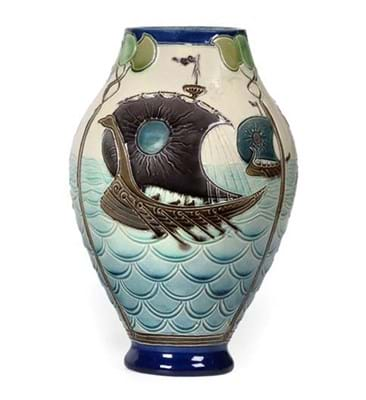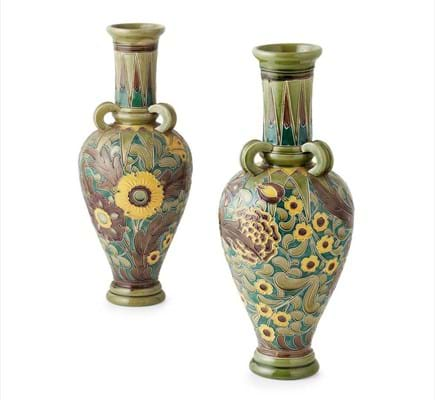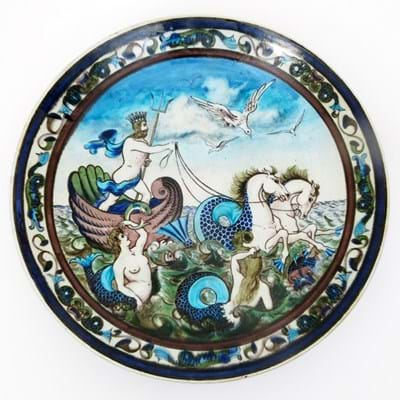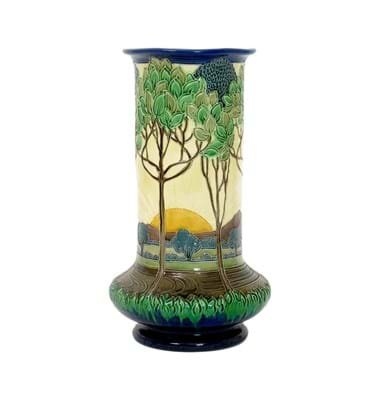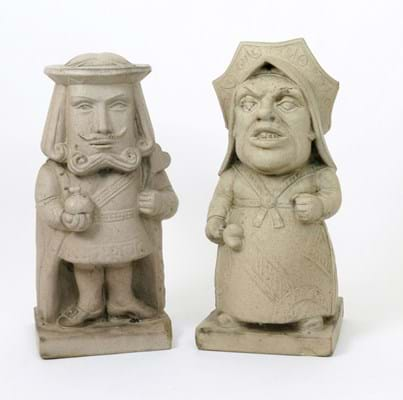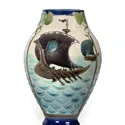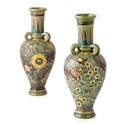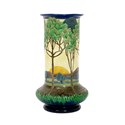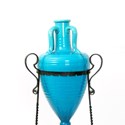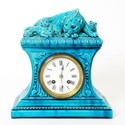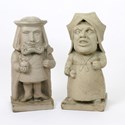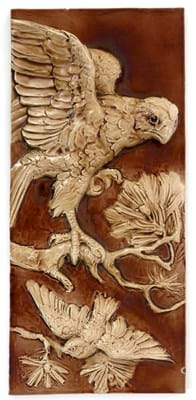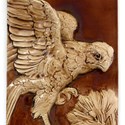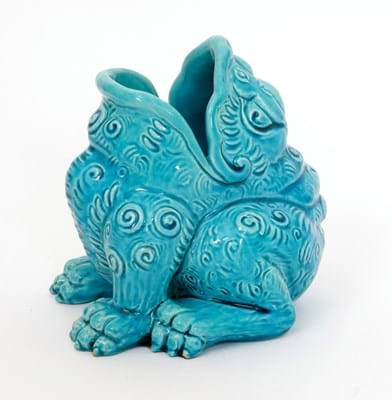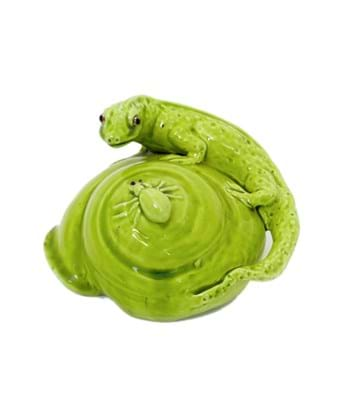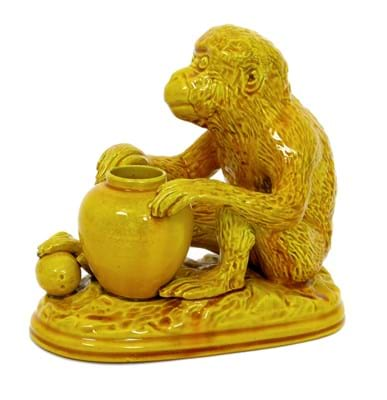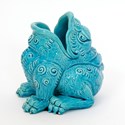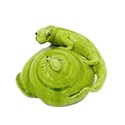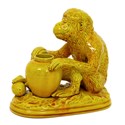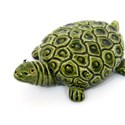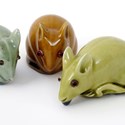Burmantofts Pottery was born out of James Holroyd’s architectural brickworks, taking advantage of the rich local deposits of both coal and clay. However, today, the church built in Shakespeare Street in 1877 to serve a growing population of artisan potters is one of the few buildings still standing from a site that once comprised 90 kilns across 16 acres.
Burmantofts output included lustre chargers in the manner of Pilkingtons, Moorcroft-style tube-lined vases, glaze colours that went far beyond the trademark brown, mustard, turquoise and red – and the occasional experimental piece that would not have looked out of place in early 20th century France.
In short, Burmantofts was the source of some of the best (and, yes, just occasionally some of the worst) of the Victorian art pottery movement.
Knowledge
Despite the renown of the factory, Burmantofts is a subject about which relatively little has been written. Much of the knowledge is held in pockets of expertise, or can only be gleaned across a variety of publications that include the catalogue from the 1983 breakthrough exhibition held at Cartwright Hall in Bradford and a privately printed work by Jason Wigglesworth, Burmantofts Faience: A Compendium of Designs.
More recently, a substantial article titled Burmantofts Decorative Tiles for Interiors was published in 2016 by the Tiles and Architectural Ceramics Society, based around the examples in the Woolley & Wallis of Salisbury sale of the ‘finest private collection’ of Burmantofts in June 2017.
What do people collect?
Burmantofts pottery encompasses everything from tiles, architectural panels, conservatory heaters to grotesques fantasies, which means there is a wide range available. With this most egalitarian of factories, there is something to match everyone’s pocket.
The most recognisable wares are the Leeds factory’s high-fired monochrome pieces or the Anglo-Persian vases that have long been the most admired and the most expensive line.
The best productions of the Burmantofts factory are admired well beyond the confines of their native Yorkshire.
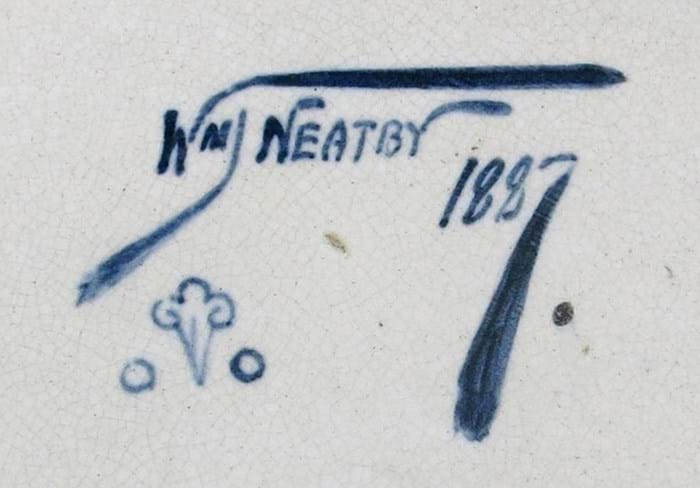
The signature of William James Neatby painted to one of a group of 1887 exhibition chargers. The ‘ice cream cone’ mark is thought to denote pieces made for the Royal Yorkshire Jubilee Exhibition in Saltaire.
As with all areas of the ceramics market, Burmantofts collectors are on the look-out for the signatures and monograms of artists who worked at the factory as well as for other identifiable marks – such as the large impressed Burmantofts Faience mark for example.
A few wares may also have an exhibition mark, such as the curious ‘ice cream cone’ symbol, thought to denote pieces made for the Royal Yorkshire Jubilee Exhibition in Saltaire in 1887.
The Burmantofts stand in Saltaire was something to behold (among the exhibits was a 3ft 8in/1.02m high vase now on display in the 1853 Gallery in Salts Mill). The exhibition represented an important moment of the factory – the following year the company, already selling its wares from Harrods and Liberty’s, opened its own showroom in London. Items with such a mark therefore carry extra value.
Key name: Leonard King
At their best, Burmantofts’ low-fired wares in the Isnik palette rival the output of William de Morgan and these works often command some of the highest prices. Most pieces carry the initials LK that the 1891 census records suggest is a factory worker by the name of Leonard King. He remains an enigma (until recently LK had acquired the more exotic moniker Louis Kramer), but he was a key figure responsible for some very skilful and stylish decoration.
Two items that achieved record prices at auction for Burmantofts were both for wares with the LK mark – the massive faience Neptune charger sold for £13,000 at Woolley & Wallis in June 2017 and a large Anglo-Persian style vase sold in 2005 also for £13,000 at Anderson & Garland in Newcastle.
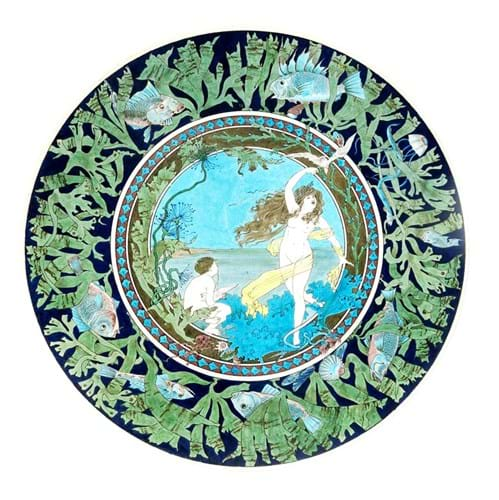
The Burmantofts faience charger that sold for £13,000 at Woolley & Wallis of Salisbury in June 2017, equalling the auction record for the Leeds pottery. Bearing an impressed ‘Burmantofts Faience’ mark, the Art Nouveau style charger with a scene from classical mythology was also inscribed with the date [18]87 and the monogram LK for the decorator Leonard King. An additional painted ‘shell’ mark is thought to denote it was exhibited at Saltaire in a show timed to mark Victoria’s golden jubilee.
Key name: William James Neatby
The Saltaire exhibition, perhaps the launch pad for the Anglo-Persian wares, was also a showcase for a series of plaques painted with ladies in Middle and Far Eastern costume by William James Neatby (1860-1910).
The Barnsley-born artist is best known for his work at Doulton, including the 1902 murals in Harrods’ food hall. However, he worked in Leeds for six years from 1884.
Relatively few signed pieces are known.
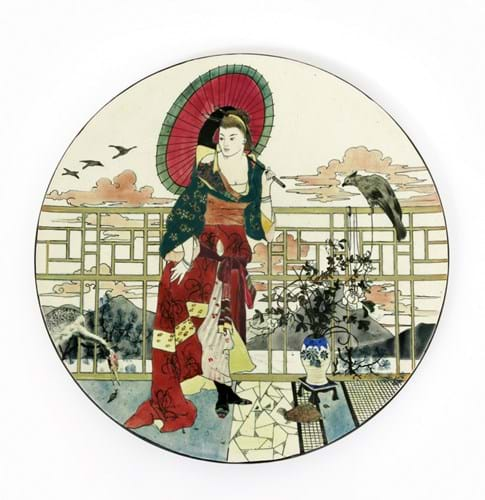
A 2ft (61cm) wall charger by William Neatby, dated 1887, depicting a geisha with a parasol standing on a balcony. Selling at £3200 at Woolley & Wallis’ single-owner sale in June 2017, it made the highest price of the four examples signed ‘Wm J Neatby’ and including the mark for the Saltaire exhibition that were offered in the sale.
Key name: Joseph Walmsley
Like Leonard King, relatively little is known about Joseph Walmsley (1865-1956), but he is closely associated with two factory ranges – the high-fired tube-lined Partie-Colour wares and those with experimental lustre glazes.
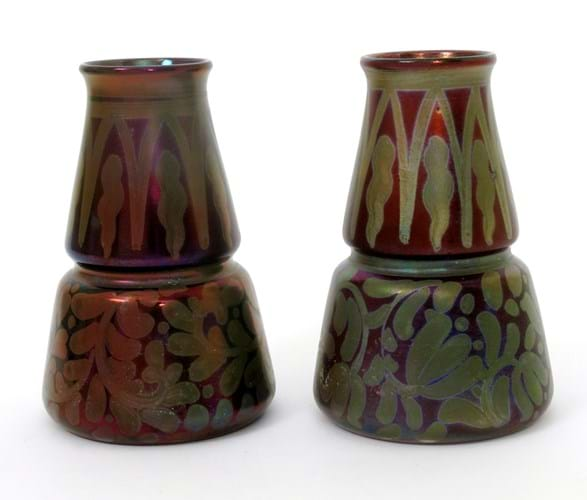
A near pair of 7in (17cm) high cylindrical form lustre vases by Joseph Walmsley painted with bands of foliage in red and golden lustre took £650.
Lustre wares were produced at Burmantofts from the 1890s. Not all bear favourable comparison with the output of contemporary rivals such as Bernard Moore or Pilkingtons but they are nonetheless desirable. Many carry the painted JW monogram.
Factory Links
The sources of many Burmantofts models is a matter of conjecture. There are close links between the factory and the Linthorpe Pottery. Many workers were taken on from the Middlesbrough factory when it closed in 1889. Among the more curious Linthorpe creations is a figural pin tray modelled after a Fijian libation vessel in the British Museum.
In Michael Whiteway’s Christopher Dresser A Design Revolution, the pottery and the wooden vessel are pictured side by side. Burmantofts produced its own version of the same dish (model no.1802). They are rare, although examples have been sold by Fieldings in 2015 (£230) and by Peter Wilson of Nantwich in 2009 (£380). An example in a turquoise glaze with applied glass eyes sold for £600 at Woolley & Wallis in June 2017.

Tiles
In keeping with an operation that began life as the Wilcox Brickworks, tile production was a key element of the Burmantofts output.
A series of sculptors and architects was engaged to produce relief-moulded designs for tiles and plaques, including the Frenchman Pierre Mallet (1836-98), who also designed for Minton, and Victor Kremer (1857-1908), who later worked at Sarreguemines.
Examples also carry initials for the Leeds art potter Harold Leach and local sculptor Edward Caldwell Spruce (c.1865-1922).
They formed the basis of the article published in 2016 by the Tiles and Architectural Ceramics Society, and many society members remain active in the market.
Several tiles created by Mallet during his time in Leeds from 1885-87 are signed in the mould or to the reverse, including a range of large 12in (30cm) square tiles modelled in relief with British birds.
These are rare tiles (just two from the series sold for £750 at Tennants in 2013) and a group of five glazed in olive green, estimated at £200-400, took £1100 at Woolley and Wallis in 2017.
A single Mallet bird tile in a blue glaze at the same sale took £350.
Animals and grotesques
Burmantofts dragon vases and grotesques are a collecting subset of their own.
Rarities offered at the Woolley & Wallis single-owner sale in June 2017 included a tortoise in a green glaze with applied glass eyes that made £380, a trio of three mice, glazed in pale green and mustard yellow that took £700 and a series of dragon models with unusual lustre glazes that took bids between £300-380 each.
Further Reading
Jason Wigglesworth, Burmantofts Faience: A Compendium of Designs.


